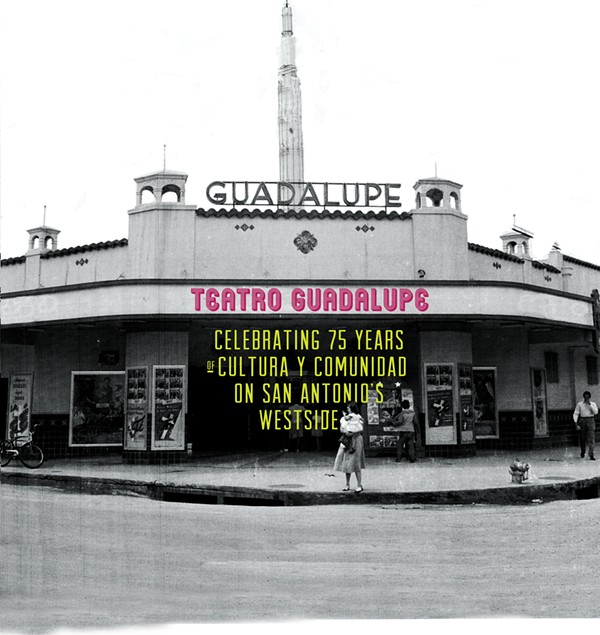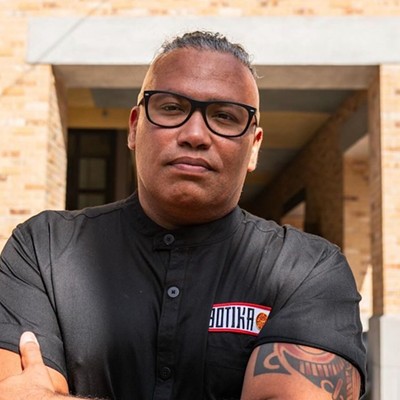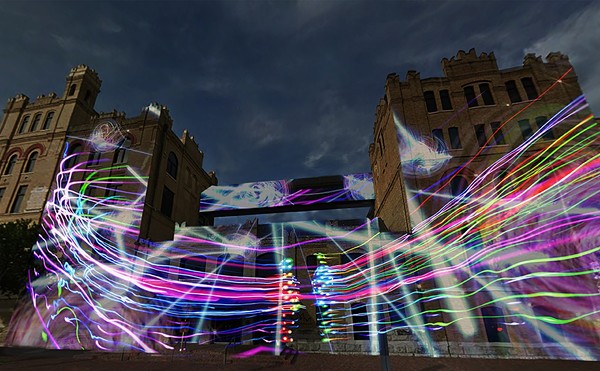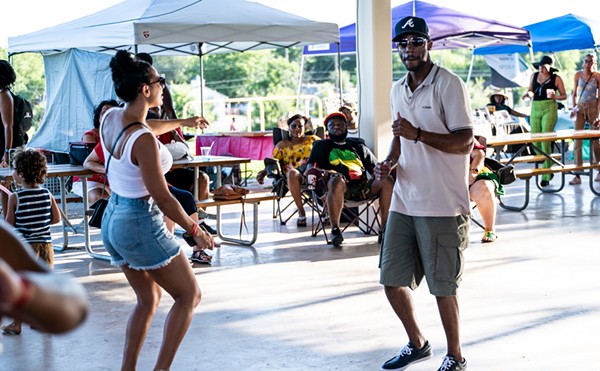This weekend, the folks of the Guadalupe Cultural Arts Center, a vibrant community arts and education organization on San Antonio’s Westside, will host a birthday celebration for its most recognizable and storied facility: The Guadalupe Theater.
Predating the cultural arts organization by nearly 40 years, the Guadalupe Theater, or Teatro Guadalupe, really was the spot when it first opened its doors back in 1942. While the nation was in the midst of World War II, an effort which obviously involved a great many men from all around Military City USA, Teatro Guadalupe provided a welcome respite.
As basically the only theater in town that specifically catered to Mexican-Americans in San Antonio, especially on the near-Westside where it is located, the theater showed films in Spanish and hosted variety shows (variedades) to complement the programming and involve performers from throughout the community.
During this time, when the iconic zoot suit (a sly form of protest against wartime austerity measures) would have been en vogue, Teatro Guadalupe was rather opulent compared to the grassroots community hub it would later become. It was a place for middle-class (and middle-class aspiring) Mexican-Americans to mingle, to let loose, and to be entertained in the language that was central to their lives.
While the theater was a thriving entertainment business, it was, nevertheless, already serving an important function as a community gathering place and a bastion of Mexican-American (and proto-Chicano) cultural identity. This was the theater’s first life: full of enthusiasm and flash, sure of itself, a bright beacon, youthful, and burning with the passion of a people who proudly refused to fully assimilate into a society that would see them dispossessed of their true identity.
Teatro Guadalupe’s success continued throughout the 1940s, '50s and '60s. By 1970, however, the place was in severe disrepair and the show, it seemed, would not go on. Dilapidated and situated in a neighborhood that was starting to feel the ravages of addiction, gangs, and a lack of upward mobility, Teatro Guadalupe lived most of its second life (throughout the 1970s) abandoned or as the Brazos Thrift Store (basically a flea market). To say, however, that Teatro Guadalupe was not also an important cultural center during this time, is to underestimate and misunderstand the value of a flea market.
It was in the late 1970s and early 1980s that a group of artists, educators, and advocates called Performance Artists Nucleus (PAN) began to eye the theater and its surrounding area as a good place to conduct its operation.
PAN, like so many other fledgling Hispanic arts and culture organizations around the country, was at once a by-product and an important driver of the Chicano movement. Theater, especially, was huge for the Chicano cause.
Educator and celebrated local poet Jacinto Cardona, who taught at Teatro Guadalupe with the Grupo Amino theater program for kids in the 1990s, told the Current that he believes theater was so valuable to the Chicano movement because “unlike speeches or rallies or books, theater is a lively form of entertainment that can also carry powerful political and cultural messages.”
“Mainstream theater, of course, didn’t speak to these Chicano communities,” Cardona said, but in creating their own theatrical productions, Chicano playwrights and actors allowed their communities to “see [themselves] and situations that [they] could relate to on the stage.” For Cardona, it was a real source of empowerment for Chicanos to see “real people that talked like [them] and looked like [them] and reflected [their] experience on a legit stage, in a legit theater.”
“Just hearing someone say, for instance, the word ‘abuelita’ on stage was something special to me,” Cardona chuckled.
By 1981, PAN, which sought to unite the many Hispanic arts groups that were competing with one another for attention and resources, had secured some assistance from the City (thanks to the persuasive powers of Councilman Bernardo Eureste) and were beginning to seriously work on the site. By 1984, renovations were complete and PAN, having rebranded as Guadalupe Cultural Arts Center (GCAC), moved in and hit the ground running. Thus began the theater’s third life, which it is still living out today, donning its latest wear and tear with pride.
For 73-year-old David Gonzalez, who attended the Teatro Guadalupe as a kid growing up nearby and later became a founding member of GCAC, the theater has always been a wellspring of cultural identity, because “museums [and other cultural institutions] weren’t actually reflective of [Chicano] identity or experience.”
Gonzalez felt called to anchor something special in this particular neighborhood because he has “a strong emotional attachment to and desire to improve the Westside.” For Gonzalez, the theater and the GCAC after it have provided a kind of antidote to the “despair, death, and addiction” that he’s witnessed in the area.
Despite a lifetime of experiences at the theater, including years of working with visual arts students and mentoring young Chicanos, Gonzalez says that his most treasured experience of the place was just a few years ago, when he saw his daughter Amelia married in the theater.
Roberto Livar, who fronts the dynamic barrio big band Bombasta, which has played the theater on a few occasions, told a similar story of his grandparents' 50th wedding anniversary being held at Teatro Guadalupe.
“As lifelong San Antonio residents, my grandparents came of age during the ‘swing era,’ they were like the first wave of Chicanismo, so many of their memories were of the swing dances held back in the day at Brackenridge Park or later at the historic La Gloria. Being able to celebrate their longevity at the historic Guadalupe Theater really seemed to bring it all home for them. My mother, aunt, and sister dressed up and sang and danced to their rendition of ‘Boogie Woogie Bugle Boy,’ I performed with musician friends at the time for the gathering and my grandparents danced all night under the swaying of lights reflected off of the disco ball overhead.”
Livar, whose grandfather recently passed, expressed his hope that one of the man’s last memories “before transcendence” was of this special occasion, in such a special place.
It’s no surprise that such important, personal ceremonies are often hosted in the theater, a place that Gonzalez refers to as “a symbol of the Westside, a symbol of all the struggles and victories, a symbol of the stories of the elders.”
Not much has really changed inside or outside the theater over the years since, though the GCAC has, often in bursts of several years at a time, continuously made a positive impact on the community.
One very noticeable external change, however, is the now iconic Our Lady of Guadalupe Veladora sculpture, created by renowned artist and San Antonio treasure Jesse Treviño. The massive veladora (votive candle) was dedicated in 2003 and gave the theater a significant facelift and gave community members just one more reason to look toward Teatro Guadalupe when in need of hope.
It is this hope and this heritage that will be celebrated on Friday evening, with a program of performances that hearken back to the 1940s glory days of the theater. The show will feature improv skits, vaudeville bits, short screenings, musical performances, dances, and more. Perhaps most importantly, many of the neighborhood elders will be on hand to share memories about the place. These stories will serve as entertainment, but they will also be recorded for posterity.
Cristina Ballí, who took the reins as Executive Director of the GCAC just under a year ago, says that the variety show, much like the historical ones it recalls, will sometimes feel “just a little bit more professional than a talent show,” but that unpredictability is part of the magic.
It’s appropriate, Ballí suggests, that this historic theater and surrounding community is being celebrated not with a grand gala, but with a folksy production that recalls a long and vibrant history.
While Ballí sees this celebration as an important time of joy and recognition of history, she also stressed the importance of continuing to invest, as a city, in the theater and GCAC in general. “It is time for more and bigger investment in the Guadalupe corridor,” she said.
“This is the only Latino/Chicano/indigenous-focused theater in Bexar County,” Joel Settles, GCAC Director of Programs, quickly added. Continuing, Settles complained that Mexican-American culture “is used to promote San Antonio to the world, but it is not fully represented in either the city budget or otherwise.”
He’s got a point. It’s perhaps only right that as we celebrate history, we advocate for a future that will allow said history to be preserved and allow all of the city’s communities to be fully represented come budget time.
Speaking of budgets, Councilwoman Shirley Gonzales, who serves the area in which the theater is located (District 5), told the Current over the phone that she was proud that over the last five years, a few large chunks of city bond money have been given for the preservation and expansion of the theater and the GCAC.
To Councilwoman Gonzales, who actually grew up not too far away, the Guadalupe corridor represents “the ideal community in miniature.” Continuing, she explained that, while the area is not without its issues, “it is a walkable community with diverse offerings that most areas of town would love to have.” As such, she is committed to maintaining and growing the impact of the GCAC in the area.
“We have a foundation here,” she said, “for an ideal community, an ideal corridor.”
This “ideal community” would not be possible without the tenacity and unshakable passion of the community that surrounds the GCAC. But, looking back, it’s clear that it might also not have been possible without the Teatro Guadalupe.

















